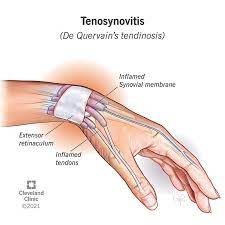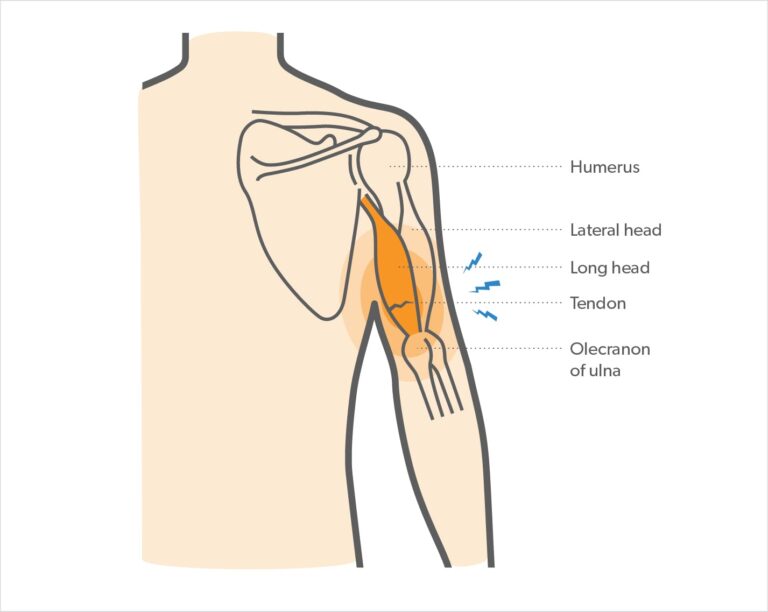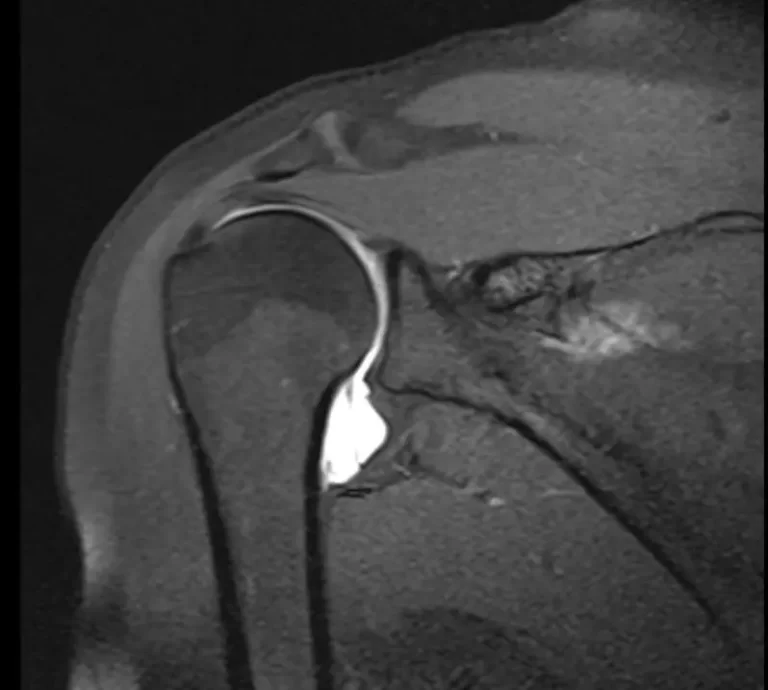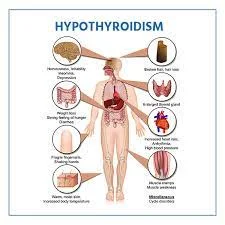Flexor Pollicis Longus Tenosynovitis
Table of Contents
Description
Flexor pollicis longus tenosynovitis, also known as de Quervain’s tenosynovitis, is a condition characterized by inflammation of the tendons that control the movement of the thumb. It usually affects the flexor pollicis longus and abductor pollicis longus tendons on the thumb side of the wrist.
Causes of Flexor Pollicis Longus Tenosynovitis
The exact etiology or cause of flexor pollicis longus tenosynovitis (also known as de Quervain’s tenosynovitis) is not fully understood. However, several factors likely influence its development. They include:
Repetitive movements of the hand and wrist:
Repetitive movements of the thumb and wrist, such as repeated gripping, squeezing, or twisting, can strain the tendons and their sheaths, causing inflammation and irritation.
Overuse or strain:
Making repetitive or forceful movements with the thumb and wrist, especially when they are combined with inadequate rest or recovery can increase the risk of tenosynovitis.
Anatomical factors:
Some people may have anatomical variations or abnormalities in the tendons or their sheaths that predispose them to tenosynovitis. For example, a tight or narrow tendon sheath can make the tendon more susceptible to inflammation and irritation.
Hormonal changes:
Hormonal changes, especially during pregnancy, are suggested to contribute to tenosynovitis. Hormonal fluctuations can cause increased fluid retention, which can lead to swelling and inflammation of the tendon sheaths.
Inflammatory diseases:
Certain inflammatory conditions, such as rheumatoid arthritis, can increase the risk of tenosynovitis. In these cases, the underlying inflammation of the joints and surrounding tissues can extend to the tendons and their sheaths.
Trauma or injury:
Direct injury or trauma to the thumb or wrist, such as a fall or collision, can damage the tendons and their sheaths, causing inflammation and tenosynovitis.
- It is important to note that although these factors are often associated with the development of flexible wrist prolapse with tenosynovitis, the condition can occur without an identifiable cause.
- In addition, individual sensitivity may vary and several factors may contribute to its occurrence.
- A consultation with a doctor can help determine the underlying cause and guide appropriate treatment.
Related anatomy
To understand flexor pollicis longus tenosynovitis, it is important to know the relevant clinical anatomy. Here are the main anatomical structures:
Flexor Pollicis Longus (FPL) Tendon:
- The flexor pollicis longus is a forearm muscle. It originates from the middle of the ulna and passes through the fibro-osseous tunnel on the palmar side of the wrist.
- The tendon then runs along the palmar side of the thumb, passes under the fibrous sheath, and attaches to the distal phalanx (skull) of the thumb.
- The main function of the FPL tendon is to flex the thumb.
Abductor Pollicis Longus (APL) Tendon:
- The Abductor pollicis longus is another muscle located on the forearm that runs parallel to the FPL muscle.
- It also passes through the same fibro-bony tunnel and runs down the palm to the thumb.
- The APL tendon helps in the abduction and extension of the thumb.
Tendon protection:
- The tendons of the FPL and APL muscles are surrounded by a synovial sheath, which is a protective layer.
- consists of two layers: the inner synovium and the outer fibrous layer.
- The tendon guard facilitates the smooth gliding of the tendons as they move through the fibro-osseous tunnel and onto the thumb side of the palm.
Fibro-osseous tunnel:
- The fibro-osseous tunnel, also known as the first back, is a passage formed by a combination of bones and ligaments on the thumb side of the wrist.
- The FPL and APL tendons pass through this tunnel with their synovial sheaths.
- When inflammation occurs in the tendon sheath and surrounding structures, such as flexor pollicis longus tenosynovitis, it can cause pain, swelling, and limited motion in the thumb.
- Understanding the anatomy helps healthcare professionals effectively diagnose and treat flexor pollicis longus tenosynovitis by targeting the affected tendons and surrounding structures.
Epidemiology
Flexor pollicis longus tenosynovitis, or de Quervain’s tenosynovitis, is a relatively common disease, especially in certain populations. Here are some key points about its epidemiology:
Occurrence:
- Flexor pollicis longus tenosynovitis is more common in women than men, with a female-to-male ratio of approximately 4:1.
- It usually affects people between 30 and 50 years of age, although it can occur at any age.
Occupation:
- Certain occupations that involve repetitive hand and wrist movements or activities that require a strong thumb flexor pollicis longus tenosynovitis occurs more during movements.
- For example, craftsmen, healthcare laborers, musicians, assembly line workers, and people who do repetitive activities such as gardening or knitting.
Pregnancy:
- The condition is more common during pregnancy, probably due to hormonal changes and fluid retention.
- Increased fluid content in tissues can contribute to inflammation and irritation of tendons and their sheaths.
Bilateral involvement:
- Flexor pollicis longus tenosynovitis can affect one or both wrists, but bilateral involvement is relatively common.
- It is estimated that up to 50% of cases involve both hands.
Risk factors:
- As previously mentioned, repetitive hand and wrist movements, overload, anatomical factors, hormonal changes in pregnancy, and certain medical conditions, such as rheumatoid arthritis, can increase the risk of developing flexor pollicis longus tenosynovitis.
Symptoms
Symptoms of flexor pollicis longus tenosynovitis usually include:
- Pain and tenderness on the thumb side of the wrist may radiate to the forearm.
- Swelling with inflammation at the base of the thumb.
- Difficulty grasping or pressing objects. A “sticky” or “clicking” feeling when moving the thumb.
- Thumb weakness or difficulty moving the thumb.
Recurrence:
- Although many cases of flexor pollicis longus tenosynovitis can be successfully treated with conservative measures, the condition tends to recur, especially if the underlying cause is not treated or if repetitive activities continue without change.
- It is important to note that the epidemiology of flexor pollicis longus tenosynovitis can vary in different populations and geographic areas. Correct diagnosis, treatment, and preventive measures can help manage the condition effectively and reduce the risk of recurrence.
Diagnosis
- Diagnosis of a patient with symptoms and symptoms of De Quervain’s tenosynovitis starts with a thorough history, observed by a physical examination.
History
- Wrist pain
- Overuse injury versus acute trauma
- History of symptoms
- Repetitive movements of the upper limbs during work or daily living (ADL)
- Manual control
- Pregnant or currently postpartum
Pain:
- The primary complaint is radial wrist pain (base of the thumb and dorsolateral aspect of the wrist near the radial styloid process) that radiates to the forearm when the thumb is grasped or extended.
- Mostly as a “continuous painful, burning sensation”.
- Repetitive lifting, grasping, or twisting movements of the arm make it worse (eg, opening a jar lid).
Medical examination
- On examination, tenderness at the base and/or first dorsum of the thumb are some important findings.
- Extensor tendons on the thumb side of the wrist, especially over the radial styloid process [Swelling in the anatomical snuff Decreased range of motion (ROM) of abduction of the first digit of the carpometacarpal (CMC) Conscious thickening of the first dorsal extensor sheaths and crepitus of the extensor tendons.
Other possible findings are include
- Weakness and paresthesia in the hand
- Provocative Finkelstein test
- During this test, the thumb is bent and held in a fist. The patient actively rotates the wrist toward the ulna. This causes sharp pain in the first dorsal compartment of the radial wrist.
Differential diagnosis of flexor pollicis longus tenosynovitis
When evaluating a patient with symptoms suggestive of tenosynovitis pollicis longus, it is important to consider other possible diseases that can cause similar symptoms. Here are a few differential diagnoses to view:
Intersection syndrome:
- Intersection syndrome involves inflammation at the junction of the tendons of the extensor muscles of the wrist and the tendons under the muscles of the forearm.
- This can cause pain and swelling in the forearm, about two inches above the wrist joint.
- Sometimes flexor pollicis longus can be confused with tenosynovitis because of its proximity etc.
Carpometacarpal (CMC) arthritis of the thumb:
- Arthritis affecting the CMC joint of the thumb can cause pain, swelling, and decreased range of motion at the base of the thumb.
- It can be distinguished from tenosynovitis by the location of the pain, which is directed more toward the joint itself than the thumb of the wrist.
Rheumatoid arthritis (RA):
- RA is a chronic autoimmune disease that can affect several joints, including the wrists and hands.
- The inflammatory changes associated with RA can cause swelling, pain, and stiffness in the affected joints.
- Differentiating RA from flexor pollicis longus tenosynovitis may require a thorough evaluation of the patient’s medical history, additional physical examination findings, and laboratory tests.
Osteoarthritis:
- Osteoarthritis, a degenerative joint disease, can affect the CMC joint of the thumb, causing pain, swelling, and limited range of motion.
- It usually develops gradually over time and may have typical signs such as bone enlargement or joint wrinkling.
Trigger Thumb:
- Trigger thumb, also known as constrictive tenosynovitis, involves inflammation and narrowing of the tendon sheath of the flexor thumb.
- This can cause pain, a popping or sticking sensation, and difficulty extending or bending the thumb.
- A thumb trigger is characterized by the thumb being stuck in a flexed position and then suddenly released (triggered) to the ear.
Ganglion cyst of the wrist:
- A ganglion cyst is a non-cancerous fluid-filled lump that usually occurs around the wrist joint or tendons.
- This can cause pain and swelling in the affected area.
- Although ganglion cysts are not usually associated with tenosynovitis, they may have similar symptoms and may need to be differentiated.
- To make an accurate diagnosis, a doctor must perform a thorough, including comprehensive, evaluation of medical history, physical examination, and any imaging studies such as x-rays or ultrasounds.
Treatment:
Surgical intervention: If conservative measures fail to provide relief, surgery may be considered. Procedural involves loosening the contracted tendon sheath to allow the tendons to move more freely. It is important to consult a doctor to obtain an accurate diagnosis and discuss the most appropriate treatment options for your condition.
1-Nonsurgical treatment of flexor pollicis longus tenosynovitis
Non-surgical treatments are often the first line of treatment for flexor pollicis longus tenosynovitis. These conservative approaches aim to relieve symptoms, reduce inflammation and promote healing. Here are some of the more common non-surgical treatments:
Rest and activity Modification:
- Avoiding or modifying activities that worsen symptoms is key.
- Resting the injured hand and avoiding repetitive motion of the thumb and wrist can help reduce inflammation and allow the tendons to heal.
- It is recommended to change jobs or leisure activities that affect the condition.
Immobilization:
- Immobilization of the thumb and wrist with a splint or brace can support and limit tendon movement.
- This immobilization helps reduce stress on the inflamed tendons and allows for recovery.
- A splint is usually used for several weeks and the duration can vary depending on the severity of symptoms and response to treatment.
Cold treatment:
- Using ice packs or cold compresses on the affected area can help reduce pain and inflammation.
- Cold treatment can be done for 15-20 minutes at a time several times a day.
- It is important to wrap the ice pack in a thin cloth to protect the skin and avoid direct contact.
Medicines:
- Nonsteroidal anti-inflammatory drugs (NSAIDs), such as ibuprofen or naproxen, can be used to relieve pain and reduces inflammation.
- These medicines should be taken according to a doctor’s instructions and be careful of possible side effects or contraindications.
Hand care and exercises:
- A physical or occupational therapist can guide you through specific exercises and stretching techniques to improve mobility, strength, and flexibility in your thumb and wrist.
- They can also provide training on ergonomic principles and posture changes to prevent recurrence and promote overall hand health.
Corticosteroid injections:
- In cases where symptoms are severe or persist despite conservative measures, a corticosteroid injection may be recommended.
- Injections are made directly into the tendon sheath to reduce inflammation and provide short-term pain relief.
- However, it is important to note that repeated corticosteroid injections can cause side effects and should be used with caution.
It is very important to consult a doctor for an accurate diagnosis and a proper treatment plan
customized for your space. They can guide the most appropriate non-surgical treatments and follow up on your progress during the healing process.
2-Physical therapy management
The development of exercise therapy is as follows:
- Strength exercises can be started by patients when pain has reduced to a manageable level, with strengthening being gradually criticized.
- Place the patient on a strengthening program only if he can tolerate its current strength program for at least 1 week.
- It is important to go slowly and for patients to get stronger without pain to prevent the worsening of symptoms.
- Below are examples of strengthening exercises.
- Abductor pollicis longus Strengthening the abductor pollicis longus muscle can help improve thumb strength, stability, and function.
- Here are some exercises commonly used to target and strengthen abductor pollicis prolapse:
Thumb abduction with resistance band:
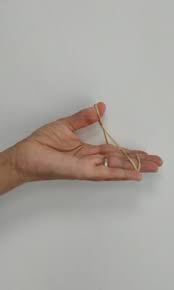
- Attach the other end of the resistance band to a stationary object.
- Hold the other end of the tape with the affected hand.
- Place your hand with thumbs up.
- Gently pull the thumb away from the fingers by stretching the band and grasping the thumb.
- Keep the position for some time and then release gradually.
- Do 10-15 repetitions and gradually increase the resistance.
Abduction of the thumb against resistance:
- Place the affected forearm on a table or other flat surface, palm down.
- Hold a small ball or towel.
- Hold your thumb against your palm.
- Try to hold the ball or towel lightly, keeping your thumb away from your fingers.
- Keep the contraction for a few seconds and then relax.
- Repeat 10-15 repetitions, gradually increasing the resistance.
Thumb abduction with thumb extension:
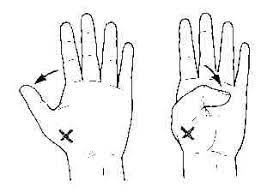
- Start with your arm in a relaxed position.
- Place the uninjured hand in the palm of the affected hand so that the thumb of the uninjured hand is over the thumb of the affected hand.
- Try to keep the injured thumb away from your fingers, if the thumb is healthy, offer gentle resistance.
- Hold the contraction for some time and then release.
- Do 10-15 repetitions and gradually increase the resistance.
Dumbbell Thumb Abduction:
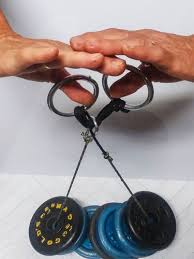
- Hold a light dumbbell (or a small household object such as a can or water bottle) in your affected hand.
- Raise your forearm on a table or other flat surface, palm down.
- For support, place your thumb against the side of the dumbbell with your fingers around it.
- Gently lift your thumb away from your fingers, keeping your thumb against the resistance of the dumbbell.
- Hold the contraction for a few seconds, then lower your thumb back down.
- Do 10-15 repetitions and gradually increase the weight of the dumbbell.
- It is important to start with a comfortable resistance level and gradually increase it as your strength improves.
- If you experience pain or discomfort during or after these exercises, reduce the resistance or consult a physical therapist for guidance.
Isometric thumb extension
Isometric exercises affect muscle contractions without visual movement in the joint. For the abductor pollicis slang, an isometric exercise can be done to extend the thumb. Here’s how you can do an isometric thumb extension exercise:

- Sit or stand in a comfortable position with the affected arm relaxed, palm down.
- Place the uninjured hand on the back of the affected hand above the joint of the thumb so that the thumb is higher than the thumb of the affected hand.
- Try to extend your thumb against the obstacle. Hold the contraction for 5-10 seconds, maintaining a constant and controlled effort without letting the thumb move.
- Relax and rest for a few seconds.
- Repeat the exercise a total of 10-15 times.
- During the exercise, focus on contracting the abductor pollicis longus muscle while keeping the rest of the hand and forearm engaged. muscles relaxed.
- It is important not to overdo it and always work without pain.
- If you experience discomfort or pain, reduce the resistance or contact your doctor or physical therapist for further instructions.
Radial deviation isometric
To perform an isometric radial deviation exercise that targets the muscles responsible for moving the wrist toward the thumb, you can follow these steps.

- Sit or stand in a comfortable position so that the affected arm rests comfortably on the table or in your lap.
- Place the affected hand with the palm facing down and the thumb towards the ceiling.
- Place the unaffected hand on top of the affected hand, above the wrist joint.
- Apply gentle resistance with the uninjured hand while trying to move the injured hand toward the thumb (radial deviation).
- Engage the muscles on the thumb side of your wrist and press against the resistance of your intact hand.
- Hold the contraction for 5-10 seconds, maintaining a constant and controlled effort without allowing any real movement in the wrist joint.
- Relax and rest for a few seconds.
- Repeat the exercise a total of 10-15 times.
- During the exercise, concentrate on working the muscles on the thumb side of the wrist.
- Remember to use gentle and controlled force and avoid straining or causing pain.
- If you feel uncomfortable or anxious, it is recommended that you consult a health professional or physiotherapist for proper guidance and to ensure that the exercise is right for you.
Thumb and finger band strengthening
- Thumb and finger band strengthening exercises are effective for improving grip strength and enhancing the stability and function of the hand. Here’s a simple exercise you can perform using a resistance band:
Grip Strengthening with Resistance Band:
Equipment needed: Resistance band (loop band or flat band)
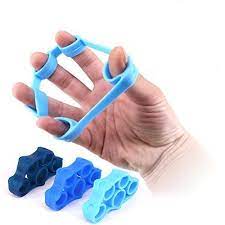
- Secure one end of the resistance band to a stationary object, such as a doorknob or a sturdy piece of furniture.
- Hold the other end of the resistance band with your affected hand.
- Start with your hand relaxed and your fingers extended.
- Slowly curl your fingers and thumb around the band, creating tension in the band.
- Continue to squeeze and hold the band for a few seconds.
- Free the tension and back to the initial position.
- Repeat for 10-15 repetitions.
- Perform additional sets as desired or recommended by your healthcare professional.
- You can also vary the exercise by performing it with each finger individually or by using different resistance bands to adjust the level of difficulty.
Ensure that you are using a resistance band appropriate for your strength level, starting with lighter resistance and gradually progressing to higher resistance as you gain strength. It’s important to perform the exercise in a controlled manner, focusing on engaging the thumb and fingers throughout the movement.
Thumb strengthening with band
Thumb strengthening exercises using a resistance band can help improve the strength and function of the muscles in your thumb.
Equipment needed: Resistance band (loop band or flat band)
- Hold one end of the resistance band in your affected hand.
- Loop the other end of the band around your fingers or anchor it to a stationary object.
- Start with your hand relaxed and your fingers extended.
- Slowly bring your thumb across your palm, towards the base of your little finger, against the resistance of the band.
- Hold the position for a few seconds, feeling the tension in the band.
- Return your thumb to the starting position, resisting the pull of the band.
- Repeat for 10-15 repetitions.
- Perform additional sets as desired or recommended by your healthcare professional.
- It’s important to focus on maintaining controlled movement and engaging the muscles of your thumb throughout the exercise.
- Start with a light resistance band and gradually increase the resistance as your thumb strength improves.
Wrist flexion with a band
Equipment needed: Resistance band (loop band or flat band)
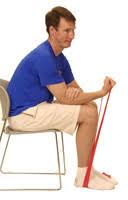
- Sit or stand in a comfortable position with your affected arm extended in front of you and the resistance band securely anchored to a stationary object.
- Hold the other end of the resistance band with your affected hand, palm facing upwards.
- Begin with the hand in a comfortable position, fingers extended.
- Slowly flex your wrist, pulling your hand towards your forearm against the resistance of the band.
- Hold the position for a few seconds, feeling the tension in the band and the contraction in your wrist muscles.
- Return your hand to the starting position, resisting the pull of the band.
- Repeat for 10-15 repetitions.
- Perform additional sets as desired or recommended by your healthcare professional.
- It’s important to maintain controlled movement throughout the exercise and avoid any jerking or sudden movements.
- Start with a light resistance band and gradually progress to higher resistance as your wrist strength improves.
Wrist band strengthening
Equipment needed: Resistance band (loop band or flat band)
- Sit or stand in a comfortable position with your affected arm extended in front of you.
- Secure one end of the resistance band to a stationary object, such as a doorknob or a sturdy piece of furniture.
- Hold the other end of the resistance band with your affected hand, palm facing downwards.
- Start with your wrist in a relaxed position, fingers extended.
- Slowly extend your wrist, pulling your hand upwards against the resistance of the band.
- Hold the position for a few seconds, feeling the tension in the band and the contraction in your wrist extensor muscles.
- Return your hand to the starting position, resisting the pull of the band.
- Repeat for 10-15 repetitions.
- Perform additional sets as desired or recommended by your healthcare professional.
- It’s important to maintain controlled movement and avoid any sudden or jerking motions.
- Begin with a lightweight resistance band and slowly increase the resistance as the wrist strength improves.
Radial Deviation with Resistance Band:
Equipment needed: Resistance band (loop band or flat band)
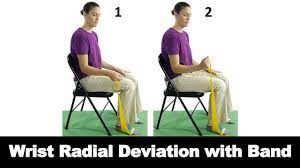
- Sit or stand in a comfortable position with your affected arm extended in front of you.
- Secure one end of the resistance band to a stationary object, such as a doorknob or a sturdy piece of furniture.
- Hold the other end of the resistance band with your affected hand, palm facing downwards.
- Keep your wrist in a neutral position, while your fingers are extended.
- Slowly move your wrist towards the thumb side (radial deviation), pulling your hand away from the midline against the resistance of the band.
- Hold the position for a few seconds, feeling the tension in the band and the contraction in your wrist muscles.
- Return your hand to the starting position, resisting the pull of the band.
- Repeat for 10-15 repetitions.
- Perform additional sets as desired or recommended by your healthcare professional.
- Focus on maintaining controlled movement throughout the exercise and avoid any sudden or jerking motions.
- Gradually increase the resistance as the wrist strength improves.
Eccentric wrist extension
Eccentric wrist extension exercises can be beneficial for strengthening the muscles involved in wrist extension while improving control and stability. Here’s how you can perform eccentric wrist extension exercises:

- Sit or stand in a comfortable position with your affected arm extended in front of you, palm facing downwards.
- Hold a dumbbell in your affected hand with a neutral grip (palm facing downwards).
- Start with your wrist in a flexed position, allowing the dumbbell to rest on the back of your hand.
- Slowly and in a controlled manner, extend your wrist against gravity, lifting the dumbbell upwards.
- Once you reach the end of the range of motion, slowly lower the dumbbell back to the starting position using an eccentric contraction.
- Focus on controlling the descent and resisting the pull of gravity.
- Repeat for 8-12 repetitions.
- Perform additional sets as desired or recommended by your healthcare professional.
- Start with a light dumbbell and gradually increase the weight as your wrist strength improves.
- Ensure that you maintain proper form and control throughout the exercise.
Eccentric Wrist Flexion with Dumbbell:
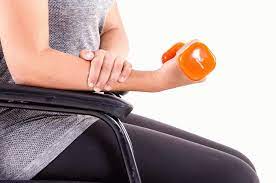
- Sit or stand in a comfortable position with your affected arm extended in front of you, palm facing upwards.
- Hold a dumbbell in your affected hand with a neutral grip (palm facing upwards).
- Start with your wrist in an extended position, allowing the dumbbell to rest on the front of your hand.
- Slowly and in a controlled manner, flex your wrist against gravity, lifting the dumbbell upwards.
- Once you reach the end of the range of motion, slowly lower the dumbbell back to the starting position using an eccentric contraction.
- Focus on controlling the descent and resisting the pull of gravity.
- Repeat for 8-12 repetitions.
- Perform additional sets as desired or recommended by your healthcare professional.
- Start with a light dumbbell and gradually increase the weight as your wrist strength improves.
- Ensure that you maintain proper form and control throughout the exercise.
Eccentric wrist radial deviation

- Eccentric wrist radial deviation exercises can help strengthen the muscles responsible for moving the wrist towards the thumb side while improving control and stability. Here’s how you can perform eccentric wrist radial deviation exercises:
- Sit or stand in a comfortable position with your affected arm extended in front of you.
- Hold a dumbbell in your affected hand with a neutral grip (palm facing downwards).
- Start with your wrist in an impartial position, fingers extended.
- Slowly and in a controlled manner, move your wrist towards the thumb side (radial deviation), against gravity, by lifting the dumbbell upwards.
- Once you reach the end of the range of motion, slowly lower the dumbbell back to the starting position using an eccentric contraction.
- Focus on controlling the descent and resisting the pull of gravity.
- Repeat for 8-12 repetitions.
- Perform additional sets as desired or recommended by your healthcare professional.
- Start with a light dumbbell and gradually increase the weight as your wrist strength improves.
- Ensure that you maintain proper form and control throughout the exercise.
Mobilization
- Mobilization with movement has shown effectiveness in decreasing pain, improving the range of motion, and improving the function of a patient with De-Quervain’s tenosynovitis.
- The therapist give a manual radial glide of the proximal row of carpals, then questioned the patient to push her thumb into radial abduction-adduction.
- Mobilization with movement completed for 5 sets of 10 repetitions and observed by eccentric hammer curl movement with theraband and high voltage electrical stimulation was shown to be effective at 6 months follow-up.
- Analyzed the analgesic impact of joint mobilization in tendinopathy and figured that the literature on joint mobilizations in tendinopathies such as De Quervain’s remains restricted since the effect of these techniques has been sparsely reported in a rare retrospective case series and case studies.
Taping
Kinesio Taping can also be used to reieve pain and improve function.
Ultrasound
Therapeutic ultrasound has also better outcomes in pain reduction and healing.
Complications of tenosynovitis treatment
Complications of tenosynovitis treatment include:
- Stiffness in the affected body part.
- Deformed tendons.
- Spread of the infection to other parts of the body (if the tenosynovitis is caused by an infection).
- Scarring.
Tenosynovitis surgery
- Surgery for tenosynovitis is generally needed if the tenosynovitis is caused by an infection, if the inflammation is so severe it’s harmful to cause permanent damage, or if conservative treatments haven’t worked after a few times (i.e. failed steroid injections).
- The surgeon will make incisions around the affected tendon to decrease pressure on it and perform a debridement (the medical term for cleaning out dead or infected tissue).
FAQ
When the flexor pollicis longus tendon becomes inflamed, it can cause a painful condition known as trigger thumb. Trigger thumb causes the thumb to lock or jam when it is in a flexed (bent) position. Inflammation occurs due to many reasons such as repetitive use, arthritis, or gout.
Trigger thumb is a simple term for stenotic flexor tenosynovitis of the thumb. This is a narrowing of the flexor tendon sheath that causes a clicking or popping sensation when the thumb is extended.
The main signs of a flexor tendon sheath infection are a slightly bent finger, fusiform swelling of the affected finger, tenderness along the flexor tendon sheath, and pain on passive extension of the finger. The suspected diaper rash infection requires immediate referral to the emergency department.
Most individuals make a full recovery with treatment. If tenosynovitis is caused by overuse and the activity does not stop, it is likely to return. If the tendon is injured, recovery may be gradual or the condition may become chronic condition.
If necessary, we recommend a non-surgical approach to see if it relieves the pain. Non-surgical treatments include Steroid injections to subside inflammation and reduce strain on the tendon sheath. Immobilization of the wrist using a splint or braces to support the thumb and wrist.

